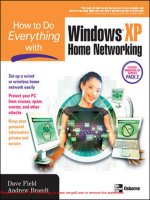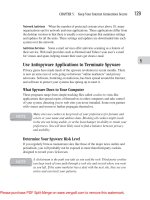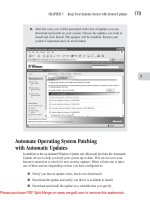Tài liệu How To Do Everything With Windows XP Home Networking- P3 pptx
Bạn đang xem bản rút gọn của tài liệu. Xem và tải ngay bản đầy đủ của tài liệu tại đây (2.45 MB, 50 trang )
Chapter 4
Install a Wireless
Network
Copyright © 2004 by McGraw-Hill Companies. Click here for terms of use.
Please purchase PDF Split-Merge on www.verypdf.com to remove this watermark.
How to…
■
Select Wireless Network Devices
■
Determine Placement of Wireless Network Devices
■
Configure Wireless Network Devices
■
Connect Your Wireless Network to the Internet
■
Share Files and Printers on Your Wireless Home Network
I
f wired Ethernet or the other wired alternatives do not work for your home
network, or you crave the mobility only wireless networking can give, you will
be found wandering the aisles of wireless network equipment at your local big-box
computer retailer. In this chapter we will discuss what you should bring home from
the store and what to do with it once you have it home. We will determine placement
of your devices and how to get them all to work together. Finally, we will connect
the whole network to the Internet.
Select the Proper Wireless Ethernet Equipment
We discussed wireless network devices in Chapter 2. In this section we will
elaborate on some of the decisions you might make and how they will affect the
layout of your network.
Choose the Device Types for Your Home Network
Many types of wireless Ethernet devices are now available for a variety of uses.
In this section we concentrate on infrastructure devices such as adapters, bridges,
and access points. We will help you decide which of the equipment in the wireless
aisle to bring home.
Internal vs. External Wireless Adapters
If you are the type who really doesn’t want to know what the inside of your computer
looks like, you will definitely want to choose an external wireless Ethernet adapter.
These connect to your computer’s USB port and can be placed on or near your
computer. If you have signal strength issues, an external adapter affords you greater
flexibility in device placement for optimum signal strength.
80
How to Do Everything with Windows XP Home Networking
Please purchase PDF Split-Merge on www.verypdf.com to remove this watermark.
CHAPTER 4: Install a Wireless Network
81
4
Ill 4-1
If you don’t mind seeing your computer’s innards, need to conserve USB ports,
or like everything nice and neat with fewer cables, you will most likely choose an
internal wireless Ethernet adapter. You will have less flexibility in device placement
(your computer will not appreciate sitting on a bookshelf), but you will also not have
to deal with an extra cable in the nest behind your computer.
Ill 4-2
Finally, if your computer is a notebook or tablet PC, you will probably opt for
a PC Card adapter. It’s not really internal, not really external.
Ill 4-3
Please purchase PDF Split-Merge on www.verypdf.com to remove this watermark.
Bridges
One last option, for wirelessly connecting a computer (or other network device)
that has a wired Ethernet port, is a wireless Ethernet bridge. This device converts
(or bridges) the wired Ethernet signal to an 802.11 wireless signal for use with
your wireless network.
Ill 4-4
Access Points vs. Gateways
If you already have an Internet-sharing device such as a wired Ethernet gateway,
you can give wireless network devices access to it by adding a wireless Ethernet
access point to your network.
Ill 4-5
If you do not already have the Internet access issues solved, there are many
excellent gateway devices that provide wireless Ethernet, wired Ethernet, even
Phoneline network access as well as security features such as firewalls.
82
How to Do Everything with Windows XP Home Networking
Please purchase PDF Split-Merge on www.verypdf.com to remove this watermark.
Ill 4-6
Choose Your Wireless Ethernet Protocol
Wireless Ethernet for consumer applications currently supports three different wireless
standards: 802.11a, 802.11b, and 802.11g. In this section we will evaluate the
differences and help you choose the one that best fits your needs.
802.11a: Less Interference
The 802.11a standard is the black sheep of the 802.11 standards. It operates on
a totally different frequency range (5 GHz versus 2.4 GHz) and is not forward or
backward compatible with any other protocol. There will be fewer devices competing
for the same airwaves with your wireless devices. On the down side, its higher
frequency penetrates less and therefore suffers from higher signal loss due to
attenuation. Distances of over 60 feet will be a challenge. Bandwidths of up to
54 megabits per second (Mbps) are possible with this standard.
802.11b: Better Compatibility
The 802.11b standard is most widely used for wireless Ethernet, and most specialty
wireless equipment uses it. Its 2.4 GHz signal penetrates better than 802.11a, but it
has more competition for the frequency range, competing with cordless phones,
wireless remote controls, and some security systems. Its speed, up to 11 Mbps, is
slower, but fine for web browsing and most home network uses. Its lower frequency
allows for better penetration of materials, giving up to 300 feet of coverage.
802.11g: Speed and Compatibility
The 802.11g standard is a second-generation 2.4 GHz standard. It supports speeds
of up to 54 Mbps and is backward compatible with devices using 802.11b. It suffers
from the interference concerns of 802.11b but offers greater penetration (up to
300 feet) than 802.11a with equal speed.
CHAPTER 4: Install a Wireless Network
83
4
Please purchase PDF Split-Merge on www.verypdf.com to remove this watermark.
Standard Frequency Band Range
1
Speed
2
802.11a 5 GHz Up to 75 feet Up to 54 Mbps
802.11b 2.4 GHz Up to 300 feet Up to 11 Mbps
802.11g 2.4 GHz Up to 300 feet Up to 54 Mbps
The Advantages of Multiprotocol Devices
You can find 802.11a/g and 802.11a/b devices that allow you to use the two protocols
interchangeably. These devices are more expensive to buy but also support the
greatest range of possible uses. An 802.11a/g device will actually support all three
standards, due to the backward 802.11b compatibility of 802.11g. Devices supporting
802.11g may also be marketed as 802.11b/g devices for the same reason.
Breaking the Speed Limit
Beginning with 802.11b, some manufacturers have included proprietary channel-
bonding techniques to effectively double the throughput of their devices. What
this means for the consumer is that if you buy only that manufacturer’s devices,
you can enable the speed-doubling technology. This function goes by different
names:
■ Xtreme G (108 Mbps 802.11g)
■ Super G (108 Mbps 802.11g)
■
Turbo (22 Mbps 802.11b)
The common denominator here is that there is no common denominator
between manufacturers. If you plan to use channel bonding, use devices all from
one manufacturer.
Channel bonding may cause interference with other networks close by, so
you might want to just check with the neighbors when you enable Super G
to make sure they are still online!
84
How to Do Everything with Windows XP Home Networking
1
Range subject to attenuation and interference.
2
Speed subject to distance, attenuation, and interference.
Please purchase PDF Split-Merge on www.verypdf.com to remove this watermark.
Place Your Wireless Network Devices
for Best Reception
Radio waves are affected differently by materials through which they pass. Cloth
and wood block them very little (unless these materials are wet), while concrete,
stone, and metal can absorb or even reflect the signal. Wireless Ethernet in the
2.4 GHz band, for instance, is readily absorbed by materials containing water,
effectively blocking the signal.
Sources of Radio Interference
Cordless phones, radio frequency wireless remotes, and even some security systems
can interfere with the 2.4 GHz signals used by wireless Ethernet devices using the
802.11b and g standards. Cordless phones are beginning to appear in the 5.8 GHz
bands (the upper end of 802.11a’s range) as well, so interference is beginning to
build there, too.
For best range, limit the number of devices that use the same frequency band.
For instance, choose a 5.8 GHz cordless phone if you are using 2.4 GHz 802.11b
or 802.11g devices.
Causes of Signal Attenuation
As mentioned previously, many materials absorb and reflect radio waves. The loss
of signal strength in this manner is referred to as attenuation. The higher a radio
frequency is, the more easily it is attenuated by materials.
Some big attenuators are
■
Water (found in wet clothing, plants, aquariums, and people)
■
Metal (found in large appliances, stucco, and reinforced concrete)
■
Stone (many rocks have high metallic and/or water content).
To minimize signal attenuation, try to position devices to minimize the amount
of attenuating material between them. Use the flashlight trick mentioned in Chapter 2.
Shine a pretend flashlight around and visualize what the beam would have to pass
through to reach your wireless network devices. Rearrange devices that would
experience high attenuation, or consider possible strategies for extending your range.
CHAPTER 4: Install a Wireless Network
85
4
Please purchase PDF Split-Merge on www.verypdf.com to remove this watermark.
Strategies for Extending Signal Range
You can extend the range of your wireless network in two ways. You can increase
your wireless device’s range with an antenna, or you can add additional access points
to increase your coverage zone.
Extend Your Range with Antennas
Antennas are available for many wireless Ethernet devices to increase effective
range, sometimes dramatically. Antennas are available in two basic types:
omnidirectional antennas that boost signals coming from all directions, and
unidirectional antennas that boost signals from a single direction only. In general,
unidirectional antennas offer the greatest improvement, as they also serve to limit
interference by pointing directly at a single source.
Some folks have built their own “cantenna” for wireless Ethernet. Starting
with a cashew can and a potato chip can, you can build a unidirectional
antenna. Instructions are found on the Internet by searching for cantenna.
Will it be better than “store-bought”? Probably not. But it is a fun experiment
in radio, and if done right it can inexpensively extend the range of your
network.
Use Repeaters to Extend Your Coverage
Another way to increase your network’s footprint is by adding repeaters. A repeater
is a device that listens for signals from a wireless access point or client and then
amplifies and retransmits them. Adding repeaters can allow you to extend your
network into areas with poorer signals, increasing the signal strength and speed
of communications in those areas.
Configure Your Wireless Network Devices
The specifics of configuring wireless Ethernet devices vary by device type and
manufacturer. In this section we will cover some of the configuration options you
should keep an eye out for so that you know if you are missing anything. Some of
this information will be presented again in much more depth in Chapter 6. We present
it here to get your network up and running, but do not rest until you have taken care
of the security. An unprotected wireless network is like going to bed with your
garage door open. You never know what you will find in there in the morning.
86
How to Do Everything with Windows XP Home Networking
Please purchase PDF Split-Merge on www.verypdf.com to remove this watermark.
CHAPTER 4: Install a Wireless Network
87
4
Find a Clear Channel
Begin your wireless configuration by finding an open channel. Nearby wireless
networks can be using default channels and would cause interference with your own.
Finding a clear channel can be accomplished with the equipment you bring home.
Perform a Site Survey
Site surveys are performed by professional installers to determine where to place
access points and repeaters. They walk around the installation site recording signal
strength with a notebook or Pocket PC equipped with a wireless Ethernet card and
wireless scanning software. They then identify weak spots and add repeaters or
additional access points where they are required.
You can approximate this by using your wireless laptop. Fire up Windows XP
and open the Network Connections Control Panel applet. Right-click your wireless
adapter and select View Available Wireless Networks. If you don’t have a laptop,
a survey can still be accomplished by using your desktop computer. Watch your
available networks for a while and see how strong the signals are from nearby
networks.
Ill 4-7
If you see other networks, note which channels they are using. When you
configure your wireless access points or gateway, choose a channel that is not in
use nearby. This will reduce interference from the neighboring networks.
Please purchase PDF Split-Merge on www.verypdf.com to remove this watermark.
Configuring a Service Set ID (SSID)
Your wireless networking devices come with a default Service Set Identifier (SSID)
that is set in the factory. These are well known to those who might want to penetrate
your network and will be used along with popular encryption keys to attempt to
get in.
Choose a new SSID and configure your equipment with it. Each device will
include instructions for configuring the SSID. You can even turn off SSID broadcast,
lowering your network’s profile to casual observers. It will not completely hide
your network from someone who is looking for it, but it is a good start.
Ill 4-8
Disabling SSID broadcast in your access points and gateways can make
earlier versions of Windows XP wireless auto-configuration malfunction.
If you experience this, obtain and install the latest Windows XP service pack.
Enabling Encryption
Wireless Ethernet devices now available support encrypted communications.
Encrypting your data makes it harder for crackers to penetrate your defenses. In
this section we will discuss Wired Equivalent Privacy (WEP) and Wi-Fi Protected
Access (WPA).
88
How to Do Everything with Windows XP Home Networking
Please purchase PDF Split-Merge on www.verypdf.com to remove this watermark.
CHAPTER 4: Install a Wireless Network
89
4
Wired Equivalent Protection (WEP)
Wired Equivalent Privacy (WEP) is the most widely used encryption standard now
available for wireless networks. It is accomplished by configuring each device with
an encryption key. These keys are available in 40-bit, 128-bit, and even 256-bit key
lengths. The numbers of bits just indicate the relative length (complexity) and
therefore strength of the key. The device uses that key to encrypt data it sends on
the network and decrypt data received from the network. WEP has had some high-
profile deficiencies exposed recently, but it remains the only choice for many until
its apparent successor, WPA, is available on all devices.
To enable WEP, use the configuration tools provided with your wireless devices
to create a key. Enter the key in the configuration of each device on the network to
enable encrypted communications.
Wi-Fi Protected Access (WPA)
Wi-Fi Protected Access (WPA) is an extension to WEP that adds the ability to
authenticate the initial connection and assign the initial key automatically. After
that, the key is changed periodically by the Temporal Key Integrity Protocol (TKIP),
which is part of the WPA standard.
WPA is designed to use a server-based authentication scheme called RADIUS
(Remote Authentication Dial-In User Service) to authenticate users to the network.
If they are accepted, their network adapter receives the initial encryption key, and
the TKIP is initialized. After that, the keys are changed periodically by the TKIP.
This prevents penetration by changing keys faster than they can possibly be broken.
Users without RADIUS servers can still make use of WPA. WPA includes the
ability to manually designate an initial key for devices using WPA. This is similar
to the static WEP key. It is used only until TKIP is initialized and begins rotating
keys.
For much more on wireless Ethernet security, please refer to Chapter 6.
Connect Your Wireless Network to the Internet
If you are using a wireless Internet gateway, chances are you have already established
your Internet connection. If not, you can work with your Internet service provider
(ISP) to configure your Internet connection to support your gateway.
Be up front about what you are doing. Most ISPs will cheerfully help you get
your network online. Some ISPs will not be happy about your connecting an entire
network to their relatively inexpensive connection. If you get too much flak, just
find a more cheerful ISP.
Please purchase PDF Split-Merge on www.verypdf.com to remove this watermark.
Configure Your Internet Gateway
Your Internet gateway will be configured with default settings to enable multiple
computers to receive IP addresses and communicate with the Internet. If you plan
to enable encryption, rename your default SSID, or disable SSID broadcast, consult
the device manufacturer’s instructions on how to accomplish this. Figure 4-1
shows a Linksys configuration screen to give you an idea of what you will see.
Enable DHCP to Control IP Addresses
By default your gateway should provide IP addresses to connected clients using
the Dynamic Host Configuration Protocol (DHCP). If this is not the case, consult
the manufacturer’s instructions to determine how to enable this.
Configure Clients for Dynamic IP Address Allocation
You might have to configure your Windows XP computers to receive dynamically
allocated IP addresses. To configure Windows XP to receive an IP address automatically,
90
How to Do Everything with Windows XP Home Networking
FIGURE 4-1
Configuring a Linksys Internet gateway
Please purchase PDF Split-Merge on www.verypdf.com to remove this watermark.
CHAPTER 4: Install a Wireless Network
91
4
1.
Open the network adapter’s Properties dialog box by right-clicking the
appropriate network connection icon in Network Connections and selecting
Properties.
Ill 4-9
2.
Find and select Internet Protocol (TCP/IP) and click Properties.
Ill 4-10
Please purchase PDF Split-Merge on www.verypdf.com to remove this watermark.
92
How to Do Everything with Windows XP Home Networking
3.
Select both the Obtain An IP Address Automatically and Obtain DNS
Server Address Automatically options and click OK.
Ill 4-11
Going Online Without a Gateway
Just as with a wired Ethernet Network, you can use the Internet Connection
Sharing capabilities built into Windows XP to share your Internet connection.
Begin by finding your connection on the Network Connections folder. You can
locate this by navigating to Start, clicking All Programs, moving to Accessories
and then Communications, and selecting Network Connections.
1.
Right-click your Internet connection and select Properties. Click the
Advanced tab and you will see the following dialog box:
Please purchase PDF Split-Merge on www.verypdf.com to remove this watermark.
CHAPTER 4: Install a Wireless Network
93
4
Ill 4-12
2.
Click “Allow other network users to connect through this computer’s
Internet connection.”
Ill 4-13
If you are curious about how Internet Connection Sharing works, you can read
the help link provided by Learn More About Internet Connection Sharing, but you
Please purchase PDF Split-Merge on www.verypdf.com to remove this watermark.
94
How to Do Everything with Windows XP Home Networking
are essentially done. If you try to connect to the Internet from another computer,
you will see your computer dial your Internet connection, and then the other computer
will begin to see web pages.
Enabling Internet Connection Sharing will change your IP address to
192.168.0.1 and enable a simple DHCP server on your computer. If you
have already chosen another IP address range, you will have to reconfigure
any static IP addresses you may have configured. Your devices and computers
with dynamically set IP addresses will change next time you start them
and will then be able to access the Internet.
Configure Your Computers for Home Networking
This section is discussed in detail in Chapter 3, but we will reprise it here with
a wireless angle.
Manage TCP/IP Addressing
If you are using an Internet gateway or have enabled Internet Connection Sharing,
you will not need to manually assign IP addresses to your devices. If you do not
want to use dynamic address assignment, you will have to configure your devices’
addresses manually.
Select Your Network’s Address Range
To communicate effectively, each device on a network requires a unique address.
This allows other devices to direct data to it without fear that the data will arrive at
the wrong location. On the global Internet, each connected device has an address—
called an Internet Protocol (or IP) address—that belongs to no other device in the
world. Obviously, it takes some level of management to ensure that no two devices
use the same address. This task is shouldered by the Internet Assigned Numbers
Authority (IANA) and your Internet service provider (ISP). When you connect
a computer or network to the Internet, you are assigned an address by your ISP
from a block given them by the IANA.
Connecting multiple devices to the Internet would require you to be assigned
an address for each device. Your ISP would want to charge you for each individual
connection, and you would use a large number of global IP addresses for your
devices. If each household did this, we would run out of addresses very quickly.
For this reason, we can choose to have a “private” range of addresses that we can
use inside our home that nobody on the Internet will care about. These address
ranges are already set aside by the IANA for private use and will never be routed
over the global Internet.
Please purchase PDF Split-Merge on www.verypdf.com to remove this watermark.
CHAPTER 4: Install a Wireless Network
95
4
While there are three ranges set aside for different-sized organizations, we will
concentrate on one specific range. This range is a collection of small network groups
using the first two octets (so-called because they’re 8-bit numbers) 192 and 168.
Addresses 192.168.0.1–192.168.255.254 are possible using these ranges, but each
network will usually stick to the same third octet number, yielding an address range
such as 192.168.100.1–192.168.100.254. The address 192.168.100.0 is set aside to
denote the network ID, and 192.168.100.255 is set aside for communications that
are destined for all devices on the network (called a broadcast).
You can safely select an address range using 192.168 and any third octet number
from 0 to 255. Each resulting network can support up to 254 devices. You will find
when you configure your Internet gateway that it may already use a group of
addresses from one of these ranges. Begin by addressing your gateway device with
<dot> one, and continue with the next number until all your devices are addressed.
Use Static Addresses
If you are not using an Internet gateway device that includes the ability to dynamically
assign addresses, or you just like to control things like that yourself, you will use
static IP addresses. Using the address range you have selected in the preceding section,
configure each device with a unique address. In Windows XP, this is managed in
the TCP/IP Properties for the network connection you are using to access the network:
1.
From the desktop, Click Start and select Control Panel.
Ill 4-14
Please purchase PDF Split-Merge on www.verypdf.com to remove this watermark.
96
How to Do Everything with Windows XP Home Networking
2.
Choose Network and Internet Connections to open the Network And
Internet Connections area of the Control Panel.
Ill 4-15
3.
Select the Network Connections Control Panel icon at the bottom of the
screen. You will see your Local Area Connection icon.
Ill 4-16
Please purchase PDF Split-Merge on www.verypdf.com to remove this watermark.
CHAPTER 4: Install a Wireless Network
97
4
4.
Right-click Local Area Connection and select Properties.
Ill 4-17
5.
Select the Internet Protocol (TCP/IP) and click Properties. You will be
presented with the following dialog box:
Ill 4-18
Please purchase PDF Split-Merge on www.verypdf.com to remove this watermark.
6.
Select the Use The Following IP Address option and configure the IP
address you have chosen.
Ill 4-19
7.
Use the default Subnet mask.
8.
Click OK to save this configuration.
You have addressed your computer to be able to communicate on your network.
As you configure more devices, and when you configure your computer or network
to communicate on the Internet, you will want to modify these settings. We will
discuss any necessary modifications later, when you connect to the Internet.
Use Dynamic Addresses
If your Internet gateway dynamically assigns addresses, you should be able to
connect to it by following the manufacturer’s instructions; if that is true, you do
not have to configure anything else in Windows XP to enable networking. If you
have to manually configure Windows XP for using a dynamically assigned
address, follow the preceding instructions, except select Obtain An IP Address
Automatically.
98
How to Do Everything with Windows XP Home Networking
Please purchase PDF Split-Merge on www.verypdf.com to remove this watermark.









